ChatGPT Stats: Key Data Including Users and Revenue (Latest)
- Update
ChatGPT Key Stats
User Base:
- Within the first 5 days of ChatGPT’s release, the number of users surpassed 1 million.
- As of January 2024, ChatGPT has over 180.5 million monthly active users (MAUs) and 100 million weekly active users.
- ChatGPT reached 100 million users in just two months, making it one of the fastest-growing consumer-level applications in history, surpassing TikTok, which took 9 months to reach the same number.

Pricing:
- The basic version of ChatGPT remains free to use.
- ChatGPT Plus, which includes upgraded features like GPT-4 Turbo technology, is priced at $20 per month.
Valuation:
- As of 2024, OpenAI, the parent company of ChatGPT, is valued at $86 billion.
- This valuation represents a significant increase from the $29 billion valuation following the release of ChatGPT.
Funding Amount:
- Since its establishment, OpenAI has raised significant funding, including a $10 billion investment from Microsoft in 2023.
- Other major funding events include Microsoft’s $1 billion investment in 2019 and initial investments from various donors in 2015.
Revenue:
- In 2022, OpenAI’s revenue was around $35 million, primarily generated through API charges to developers.
- OpenAI’s revenue is forecasted to reach $200 million in 2023 and is predicted to generate $1 billion in 2024.

(Source of data: Bloomberg.com and official announcements from OpenAI)
About ChatGPT
Release Date | November 30, 2022 |
Features | Chatbot |
Users | 100 million |
Pricing | Free or $20/month |
Developer | OpenAI |
Headquarters | San Francisco |
Website | chat.openai.com |
CEO | Sam Altman |
ChatGPT Paid User Statistics
As of 2024, ChatGPT has over 180.5 million monthly active users (MAUs) and 100 million weekly active users. ChatGPT Plus, the paid version of ChatGPT, was launched on February 1, 2023, with a subscription fee of $20 per month. The specific number of paid users has not been publicly disclosed.
Statistics of OpenAI users after ChatGPT was released
Since the launch of ChatGPT, the number of users has increased rapidly. ChatGPT reached 1 million users in just five days after its launch and achieved 100 million users in the first couple of months. As of 2024, the chatbot has over 180.5 million MAUs.
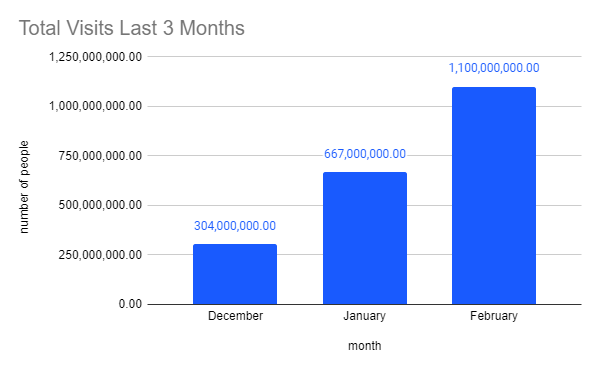
Distribution of ChatGPT users by region
The United States has the highest number of ChatGPT users, accounting for nearly 15% of the total user base. Other significant user bases include India, Colombia, the Philippines, and Japan. The growth in user traffic from these countries has been substantial, with the United States showing a year-on-year growth of 63.33%.

Gender and age distribution of ChatGPT users
The gender ratio of ChatGPT users is approximately 55.06% male and 44.94% female. The largest user age group is between 25 and 34 years old, making up a significant portion of the user base.
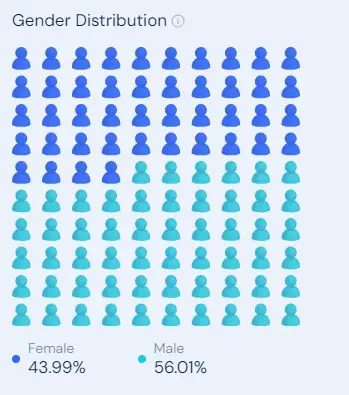
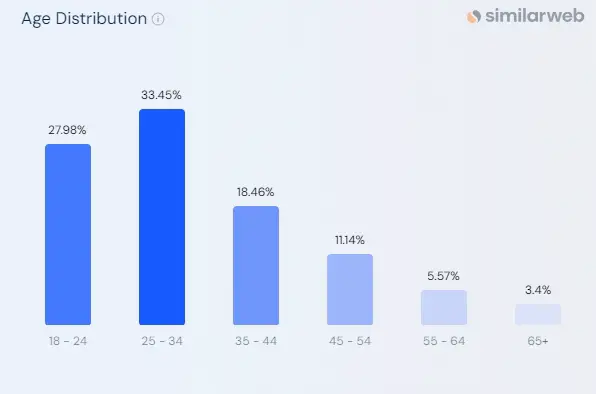
ChatGPT Revenue
ChatGPT is forecasted to generate a revenue of $1 billion in 2024. OpenAI, the parent company of ChatGPT, spends approximately $700,000 every day to operate ChatGPT. The revenue of OpenAI was approximately 35 million dollars in 2022, mainly through API charges to developers.
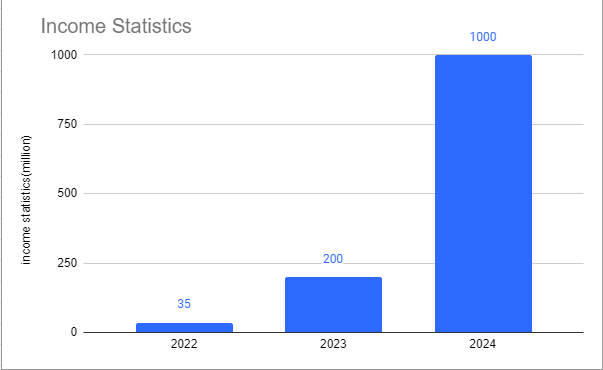
ChatGPT History
ChatGPT is developed based on the GPT-3 large language model. It has been continuously researched and developed for 5 years since the release of the GPT model by OpenAI. If counting from the establishment of OpenAI in 2015, it has already been 8 years.
- On June 11, 2018, OpenAI released a paper entitled “Improving Language Understanding by Generative Pre-Training”, in which they introduced the Generative Pre-trained Transformer (GPT), which at this time can be considered as the origin of the GPT model
- February 14 2019, Open AI first announces GPT-2
- November 2019 ,OpenAI publishes the full version of the GPT-2 language model
- May 2020 OpenAI, a San Francisco-based AI research lab, releases GPT-3, the successor to GPT-2
- July 2020 GPT-3 goes into Beta testing
- November 30 2022 Initial ChatGPT Released
- December 5 2022 ,ChatGPT crossed 1 million users
- December 2022 Valuation of its parent company Open AI reaches $29 billion
- January 31,2023, ChatGPT achieved 100 million users, becoming the fastest consumer-oriented application to reach this milestone.
- On February 1st, 2023, ChatGPT Plus was released with a pricing of $20 per month.
- March 14, 2023: GPT-4, the latest iteration of the Generative Pre-trained Transformer models, was released. This version brought significant improvements in language understanding and generation capabilities.
- April 1, 2023: Italy reportedly blocked access to ChatGPT, reflecting the growing concerns and regulatory challenges associated with AI technologies in different parts of the world.
- May 18, 2023: OpenAI launched the ChatGPT app for iOS, making the AI chatbot more accessible to a broader range of users and syncing history across devices.
- June 2023: ChatGPT’s Android application surpassed 10 million downloads, indicating its growing popularity among mobile users.
- July 2023: OpenAI introduced new voice and image capabilities in ChatGPT, enhancing the user experience by allowing more intuitive interaction types.
- August 28, 2023: OpenAI launched ChatGPT Enterprise, offering enterprise-grade security, privacy, and advanced data analysis capabilities.
- September 2023: OpenAI discontinued the waitlist for the DALL.E image generator, allowing users to sign up for the advanced version, DALL.E 2.
- October 2023: ChatGPT reached a new milestone with over 1.5 billion website visits in a single month, showcasing its widespread use and popularity.
- November 6, 2023: At OpenAI’s first in-person event in San Francisco, GPT-4 Turbo was introduced, featuring enhanced capabilities and data up to April 2023.
- December 2023: OpenAI’s valuation was reported to be around $86 billion, with significant investments from companies like Microsoft.

Open AI Key Data Stats:
Founding Time | 2015 |
Founders | Sam Altman (CEO), Elon Musk (Co-founder; resigned in 2018) |
Headquarters | San Francisco |
Business Direction | AI |
Number of Employees | 375 (as of January 2023) |
Products | ChatGPT, Dell-E,GPT-3,Whisper |
Number of Users | Over 100 million |
Annual Revenue | $35 million (2022) |
Amount of Funding | Over $120 billion |
Valuation | $29 billion |
Investment Institutions | Microsoft, Khosla Ventures and LinkedIn co-founder Reid Hoffman. |
Website |
Additional Information:
- OpenAI was founded on December 11, 2015 and was originally positioned as a non-profit artificial intelligence research company. The company was co-founded by Sam Altman, Elon Musk, Greg Brockman, Reid Hoffman, Jessica Livingston, Peter Thiel, Amazon Web Services (AWS), Infosys and YC Research, with Sam Altman and Elon Musk serving as Co-chairs. The funders have collectively committed $1 billion to support OpenAI.
- On January 30, 2017, the OpenAI team had reached 45 people.
- In 2018, Elon Musk resigned from the board due to potential conflicts of interest with his role as CEO of Tesla, which is developing AI for self-driving cars. However, he remained a donor.
- On June 11, 2018, OpenAI released a paper titled “Improving Language Understanding by Generative Pre-Training,” in which they introduced the Generative Pre-trained Transformer (GPT).
- On March 12, 2019, OpenAI announced that it was restructuring as a “capped-profit” company, which limits returns from investments beyond a certain point.
- On July 22, 2019, OpenAI announced that Microsoft had invested $1 billion to support the development of Beneficial AGI.
- On February 14, 2019, OpenAI first announced GPT-2.
- On May 28, 2020, OpenAI first mentioned GPT-3 in a paper.
- On June 11, 2020, OpenAI began offering the GPT-3 API to the public.
- On January 5, 2021, OpenAI first announced DALL-E, a model that creates images based on textual descriptions.
- On April 6, 2022, OpenAI released DALL-E 2.
- On November 30, 2022, OpenAI released the Initial ChatGPT.
- On January 23, 2023, OpenAI announced a new round of financing from Microsoft, reportedly worth $10 billion.
- On January 31, 2023, OpenAI launched a classifier trained to distinguish between AI-written and human-written text.
- On February 1, 2023, ChatGPT Plus was released with a pricing at $20/mo.
- March 14, 2023: OpenAI released GPT-4, an advanced version of its language model, which significantly improved language understanding and generation capabilities.
- April 1, 2023: Access to ChatGPT was reportedly blocked in Italy, highlighting the regulatory challenges and concerns about AI technologies globally.
- May 18, 2023: The ChatGPT app for iOS was launched by OpenAI, expanding the accessibility of the AI chatbot to a wider user base and enabling synchronization of user history across devices.
- June 2023: The ChatGPT application for Android surpassed 10 million downloads, indicating its increasing popularity among mobile users.
- July 2023: OpenAI introduced new voice and image capabilities in ChatGPT, enhancing the user experience by allowing more intuitive types of interaction.
- August 28, 2023: OpenAI launched ChatGPT Enterprise, offering enterprise-grade security and privacy, along with advanced data analysis capabilities.
- September 2023: OpenAI made DALL.E 2 more accessible by discontinuing the waitlist for the advanced image generator.
- October 2023: ChatGPT achieved over 1.5 billion website visits in a single month, demonstrating its widespread use and popularity.
- November 6, 2023: At OpenAI’s first in-person event in San Francisco, the GPT-4 Turbo was introduced, featuring enhanced capabilities and data updated to April 2023.
- December 2023: OpenAI’s valuation was reported to be around $86 billion, with significant investments from major tech companies like Microsoft.
References:
- OpenAI – Wikipedia
- “Microsoft Adds $10 Billion to Investment in ChatGPT Maker OpenAI”. Bloomberg.com
- Introducing OpenAI-OpenAI Announcements
- Team Update-OpenAI Announcements
- OpenAI LP-OpenAI Announcements
- Microsoft Invests In and Partners with OpenAI to Support Us Building Beneficial AGI– OpenAI Announcements
- OpenAI API-OpenAI Announcements
- Reducing Bias and Improving Safety in DALL·E 2-OpenAI Announcements
- ChatGPT: Optimizing Language Models for Dialogue-OpenAI Announcements
- Introducing ChatGPT Plus-OpenAI Announcements
- Language Models are Few-Shot Learners-Cornell University CS
ChatGPT Technical information Statistics

(Source from OpenAI official website)
GPT-4 Model Training Data
GPT-4, an evolution of its predecessor, is a highly sophisticated autoregressive language model, boasting an unprecedented scale with over 1 trillion parameters, a significant leap from GPT-3’s 175 billion. This expansion in scale allows GPT-4 to deliver even more remarkable performance across a diverse array of natural language processing (NLP) tasks. These tasks include, but are not limited to, complex translation, intricate question and answer scenarios, advanced cloze activities, and tasks that necessitate real-time inference or rapid adaptation to specific domains.
The model’s training involved an extensive and diverse dataset, encompassing a vast range of internet text. This comprehensive dataset enables GPT-4 to generate more contextually relevant and nuanced responses, demonstrating a deeper understanding of human language nuances. Despite its advancements, the OpenAI research team acknowledges that GPT-4, like its predecessor, encounters challenges in certain areas. These include few-shot learning scenarios where the model still requires refinement and datasets that underscore theoretical and practical complexities inherent in training such large-scale language models. The team continues to explore these challenges, aiming to enhance GPT-4’s capabilities and address the limitations identified in its extensive training process.
Investment in the Development of ChatGPT
Investment in the development and operation of ChatGPT, a groundbreaking AI language model, involves significant financial commitments, particularly in terms of computing resources. Hosted on Microsoft’s Azure cloud server, ChatGPT utilizes the powerful A100 GPU, for which Microsoft charges approximately $3 per hour. This rate is a crucial factor in the overall operational cost of ChatGPT.
The cost structure for generating text with ChatGPT is meticulously calculated. Each word produced by ChatGPT incurs a charge of $0.0003. Given that the average response from ChatGPT comprises around 30 words per request, this translates to a cost of about 1 cent per interaction. This estimation aligns closely with Sam Altman’s statement, suggesting that the cost of using ChatGPT is “probably single-digits cents” for each usage.
Based on these figures, the daily operational cost of running ChatGPT is substantial. Calculations indicate that the cost is at least $100,000 per day, which amounts to around $3 million per month. It’s important to note that this figure covers only the technological aspects of running the service and does not include the salaries of employees involved in the development, maintenance, and improvement of ChatGPT. This significant investment underscores the resource-intensive nature of maintaining and advancing a state-of-the-art AI language model like ChatGPT.
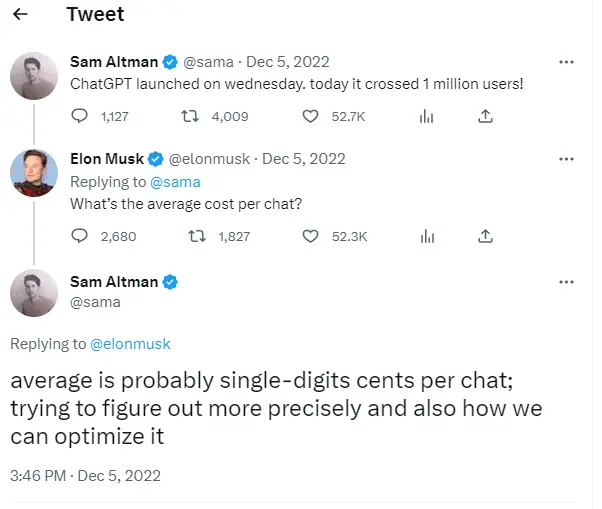
ChatGPT Challengers
Bard
Bard, emerging as a notable challenger in the realm of AI language models, represents a significant stride in the field of artificial intelligence. Developed as a response to the growing demand for sophisticated AI-driven conversational agents, Bard is designed to offer an alternative to the widely recognized ChatGPT.
Crafted with advanced natural language processing capabilities, Bard aims to provide users with an interactive and intuitive conversational experience. It leverages a deep learning framework, enabling it to understand and respond to a wide range of queries with remarkable accuracy and relevance. The model is trained on a diverse dataset, encompassing various genres of text, to ensure a well-rounded understanding of language nuances and user intents.
One of the key features of Bard is its ability to adapt to different conversational contexts, making it suitable for a variety of applications, from customer service and virtual assistance to creative writing and educational support. The model is also designed to continuously learn from user interactions, enhancing its responses over time and providing a more personalized experience.
In addition to its conversational prowess, Bard is engineered with a focus on ethical AI practices. It incorporates mechanisms to handle sensitive topics responsibly and to avoid generating harmful or biased content. This commitment to ethical AI sets Bard apart in a landscape where responsible AI usage is increasingly paramount.

Claude
Claude, developed by Anthropic, emerges as a notable challenger to ChatGPT in the realm of AI language models. Here are key aspects of Claude:
- User-Friendly and Conversational: Claude is designed to be highly user-friendly, focusing on delivering conversational and coherent responses. It aims to provide a more intuitive and natural interaction experience for users.
- Ethical AI Design: A significant emphasis is placed on ethical considerations in Claude’s development. Anthropic prioritizes creating an AI that aligns with user intentions and ethical guidelines, reducing the risk of harmful outputs.
- Advanced Language Understanding: Claude demonstrates a deep understanding of language nuances, making it adept at handling a wide range of conversational topics and queries.
- Customizable Responses: One of Claude’s strengths is its ability to tailor responses based on user preferences and needs, offering a more personalized interaction.
- Safety and Reliability: Safety features are integrated into Claude to ensure that the interactions are not only informative but also safe and reliable. This includes filters to prevent the generation of inappropriate content.
- Continuous Learning and Improvement: Claude is built to continuously learn and improve from user interactions, enhancing its performance and accuracy over time.
- Broad Application Spectrum: Claude is suitable for various applications, from casual conversations to more complex tasks like content creation, making it a versatile tool for both personal and professional use.

